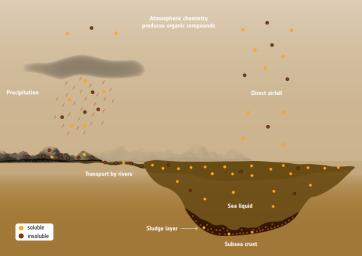
|
Organic Compounds in Titan’s Seas and Lakes
- Click the image above for a larger view
- Full-Res JPEG (3508 x 2480) (255.9 kB)
- Full-Res TIFF (3508 x 2480) (2.1 MB)
Caption:
This labeled graphic illustrates how different organic compounds make their way to the seas and lakes on Titan, the largest moon of Saturn.
A recent study adds to evidence that Ligeia Mare, one of Titan's three large seas, consists of pure methane and likely has a seabed covered by a sludge of organic-rich material.
In the atmosphere of Titan, nitrogen and methane react to produce a wealth of organic molecules. Scientists believe that the heaviest of these molecules fall to the surface. When they reach the sea, either by directly falling from the air, via rain or through rivers, some (shown in yellow) become dissolved in the liquid methane, while the insoluble ones -- such as nitriles and benzene (shown in brown) -- tend to sink to the sea floor.
Background Info:
The Cassini-Huygens mission is a cooperative project of NASA, the European Space Agency and the Italian Space Agency. JPL, a division of the California Institute of Technology, Pasadena, manages the mission for NASA's Science Mission Directorate in Washington.
For more information about the Cassini-Huygens mission visit http://saturn.jpl.nasa.gov and http://www.nasa.gov/cassini .
Cataloging Keywords:
| Name | Value | Additional Values |
|---|---|---|
| Target | Titan | Saturn |
| System | Saturn | |
| Target Type | Satellite | Planet |
| Mission | Cassini-Huygens | |
| Instrument Host | ||
| Host Type | ||
| Instrument | ||
| Detector | ||
| Extra Keywords | Atmosphere, Color, Methane | |
| Acquisition Date | ||
| Release Date | 2016-04-26 | |
| Date in Caption | ||
| Image Credit | ESA | |
| Source | photojournal.jpl.nasa.gov/catalog/PIA20026 | |
| Identifier | PIA20026 | |
